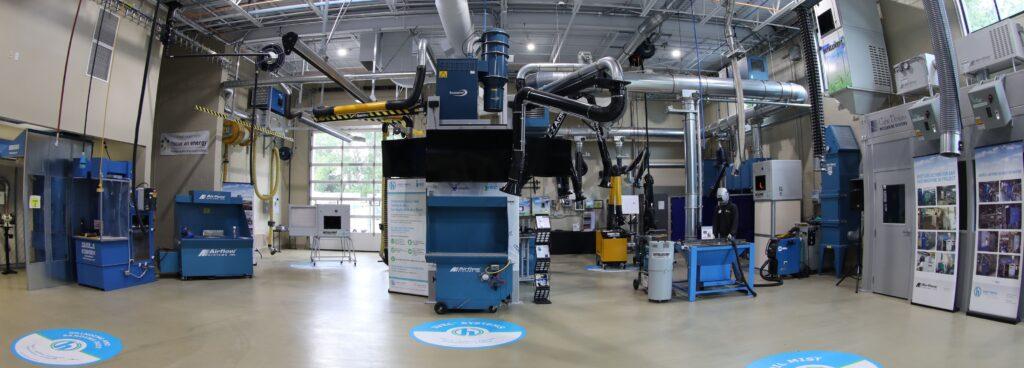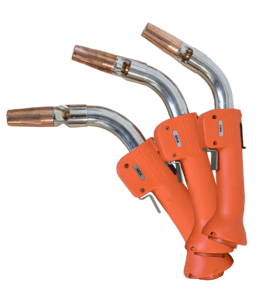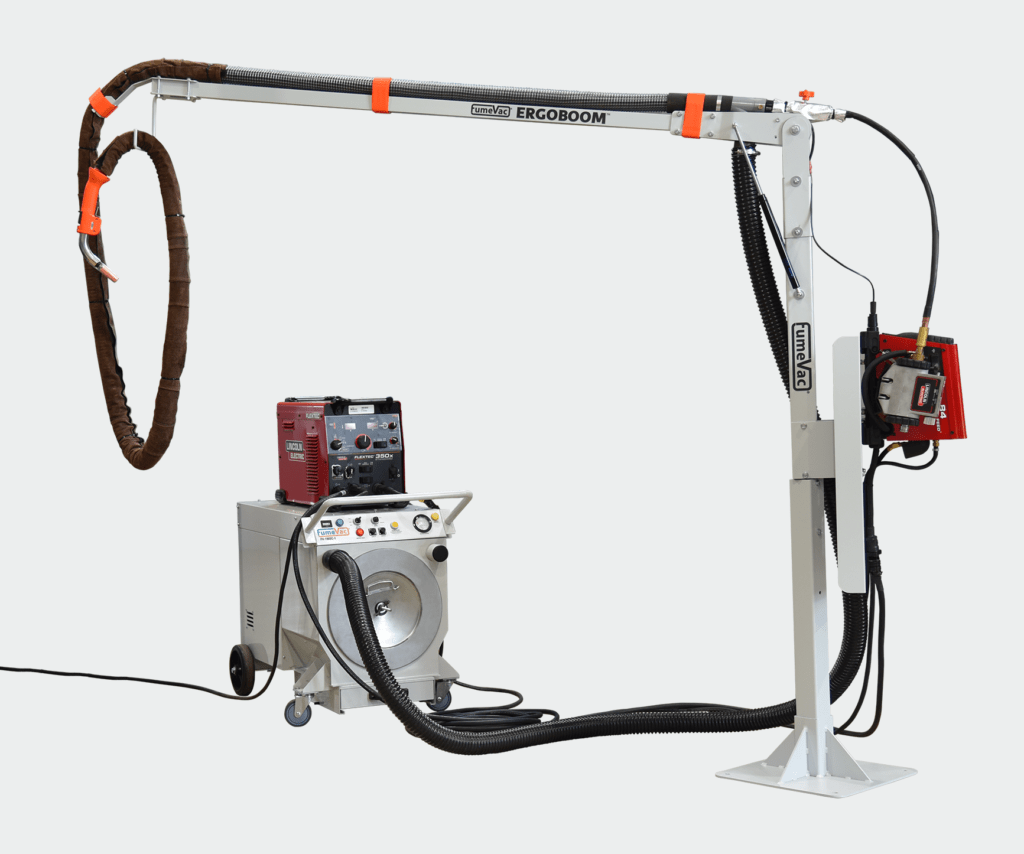In a compelling exchange at the Wisconsin Manufacturing & Technology Show, we sat down with Jim Logan, Sales Director of FumeVac—a product line owned by Hastings Air Energy Control Company. Jim brings over 35 years of experience in the welding industry, transitioning from creating smoke to mastering its efficient extraction. Our conversation delved into the nuances of the FumeVac system, including its components like the ErgoMax MIG Gun, the ErgoBoom, and the innovative FV-190SC high vacuum unit for welding fume extraction. Jim’s insights into this state-of-the-art system, coupled with his knowledge of robotic applications and welder safety concerns, offer a detailed perspective on modern welding technology and workplace health.
 Could you start by telling us about the primary focus of the FumeVac system?
Could you start by telling us about the primary focus of the FumeVac system?
Certainly! The FumeVac system, a specialty of Hastings Air Energy Control, Inc., is designed primarily for extracting welding fumes. It’s very effective for many different applications, including semi-automatic, automatic, and robotic welding. Thanks to my extensive background in welding, the design and implementation of this system draw upon my 35 years of industry experience, focusing now on cleaning up the process and efficiently extracting welding smoke.
Can you explain the features of the ErgoMax MIG Gun and how it manages to extract fumes without affecting the shielding gas?
The ErgoMax MIG Gun is an integral part of our system, designed to handle up to 500 amps. One unique feature is the extraction port location, situated at an optimized distance from the end of the gas nozzle, minimizing potential interference with the gas during operation. Despite potential concerns, the negative pressure generated around the torch neck effectively redirects smoke into the extraction ports without significantly affecting the shielding gas. Moreover, to address certain challenges like working in tight corners, the gun includes a port to modify airflow and reduce extraction at the nozzle, ensuring the shielding gas isn’t pulled away inadvertently. Impressively, this design and its high airflow rates also cools the gun’s internal components, allowing for lighter weight design components without compromising on amperage capacity.
 Tell us more about the ErgoBoom and how it contributes to both efficiency and safety in welding operations.
Tell us more about the ErgoBoom and how it contributes to both efficiency and safety in welding operations.
The ErgoBoom is a novel addition to our product line. It’s a custom-designed, six-foot boom that enhances mobility and safety. By running the gun down the boom’s length, we utilize overhead space, freeing the floor from clutter and potential tripping hazards. This arrangement also protects the gun from physical damage and weld spatter exposure, leading to increased durability and reduced maintenance costs. The 15-foot gun reach ensures excellent mobility within the welding cell, while the overall design of the ErgoBoom significantly eases the physical strain on operators who no longer need to maneuver a heavy gun cable around their workspace.
What makes the FumeVac High Vacuum Unit stand out, particularly in its capability to handle fumes from high amperage welding applications?
The FumeVac High Vacuum FV-190SC Unit is our latest innovation, showcasing exceptional performance in fume extraction. Available in single and dual gun models, it offers from 90 to 115 CFM of airflow at around 90 inches of vacuum pressure – substantially higher than typical systems. Its effectiveness lies in its capacity to provide exceptional levels of airflow, crucial for capturing fumes in high amperage situations (up to 400 amps). The unit also incorporates a 158 square foot high-efficiency filter, push-button vibratory filter cleaning, and a durable 460 volt, 3-phase brushless motor design. These features, particularly the brushless motors, contribute to the unit’s longevity and reliability in industrial settings, where frequent maintenance and motor failures can be costly.
Can you describe how the FumeVac system is adapted for robotic welding applications and its advantages over traditional methods?
For robotic welding, the FumeVac system offers a significant high-tech advancement. By encasing the existing robotic torch in a custom-designed, 3D-printed housing, the process doesn’t require costly equipment modifications. The system targets an extraction rate of about 150 CFM, successfully capturing fumes even at 350-400 amp levels. This approach not only improves the welding environment by reducing the need for hoods and large-scale air movement but also contributes to keeping the robot and workspace cleaner. The reduced need for enclosing the welding area under a hood enhances visibility and lighting, offering a more pleasant and efficient working environment. Furthermore, it addresses the growing need for effective, economical solutions in maintaining cleaner, brighter, and healthier workshops, particularly in new facilities where companies are increasingly conscious of workplace aesthetics and safety.
How does the FumeVac system address critical safety concerns, particularly regarding the exposure to harmful elements like manganese and hexavalent chromium during welding?
Welder safety is a paramount concern for us, especially regarding exposure to elements like manganese and hexavalent chromium. While the OSHA permissible exposure limit (PEL) for manganese is still abnormally high, the ACGIH (American Conference of Governmental Industrial Hygienists) recommended threshold limit value (TLV) for manganese is set at a very low level, and even at this level it still poses a significant challenge in welding environments due to its higher percentage in weld fumes. FumeVac’s high extraction rate and efficient filtering system significantly reduce manganese concentration in the air, promoting a safer workspace. Similarly, hexavalent chromium, known for its carcinogenic properties, although present in lower concentrations, demands equally stringent control measures. Our system’s design and filtration capabilities aim to maintain air quality well within the acceptable ACGIH TLV and OSHA PEL for these substances, ensuring not just regulatory compliance but, more importantly, the health and safety of the welding workforce.
Jim Logan’s expertise and insights shed light on the innovative aspects of the FumeVac system, revealing its critical role in enhancing both efficiency and safety in modern welding operations. From the ergonomic design of the ErgoMax MIG Gun to the practicality of the ErgoBoom and the powerful extraction capabilities of the new FV-190SC High Vacuum Unit, FumeVac stands as a testament to advanced engineering in combating workplace hazards.
 David Bohrer – President
David Bohrer – President
David Bohrer is Hastings Air Energy Control’s Chief Executive Officer and Chairman of the Board. Under David’s leadership, the company has grown 2400% and has developed award-winning and patented products that have revolutionized the air filtration industry. In addition to David’s executive duties, he remains one of the company’s top business development engineers. His client list includes numerous Fortune 500 and Fortune Global 500 companies who have chosen Hastings to design air filtration systems for their global facilities. David’s expertise is solving indoor air pollution with a specialty in on-demand general ventilation systems.
Welder Safety Concerns
Welding, a critical process in manufacturing and construction, exposes workers to various hazards. Understanding and addressing these hazards is paramount for maintaining a safe and healthy workplace.
Fumes and Gases
- Risks: Welding fumes contain a mix of metals like manganese, aluminum, and compounds like ozone and nitrogen oxides. Long-term exposure can lead to lung, larynx, and urinary tract problems, among others.
- Mitigation: Use of effective fume extraction systems like FumeVac, adequate ventilation, and personal protective equipment (PPE) can significantly reduce the risk.
Radiation and Heat Exposure
- Risks: Ultraviolet and infrared radiation from welding arcs can cause skin burns and eye injuries (like “welder’s flash”).
- Mitigation: Proper shielding, using helmets with correct shade lenses, and protective clothing (like leather gloves and aprons) safeguard against burns and radiation.
Electrical Hazards
- Risks: Electric shock, a primary hazard for welders, can lead to severe injuries or death.
- Mitigation: Ensuring equipment is properly grounded, using insulated gloves, and keeping the work area dry are essential preventive measures.
Physical Strain
- Risks: Continuous physical strain and repetitive motions can lead to musculoskeletal disorders.
- Mitigation: Ergonomic equipment (like the ErgoMax MIG Gun and ErgoBoom), frequent breaks, and proper technique can help minimize these risks.
Noise
- Risks: Long-term exposure to high noise levels can cause hearing loss.
- Mitigation: Use of earplugs or earmuffs in high-noise areas is a simple, yet effective way to protect hearing.
Hazardous Materials
- Risks: Handling metals coated with or containing hazardous substances (like hexavalent chromium in stainless steel) requires caution.
- Mitigation: Awareness, proper training, and use of PPE can significantly mitigate these risks.
Ensuring Safety
To ensure welder safety and wellbeing, it’s crucial to use the right tools, technologies such as the FumeVac system, and personal protective equipment, along with providing continuous safety training and regular health and air quality checks. These steps help employers adhere to safety regulations and promote a culture of safety, essential for the industry’s long-term health and worker welfare.














































